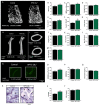Renal Proximal Tubule Cell Cannabinoid-1 Receptor Regulates Bone Remodeling and Mass via a Kidney-to-Bone Axis
- PMID: 33671138
- PMCID: PMC7922053
- DOI: 10.3390/cells10020414
Renal Proximal Tubule Cell Cannabinoid-1 Receptor Regulates Bone Remodeling and Mass via a Kidney-to-Bone Axis
Abstract
The renal proximal tubule cells (RPTCs), well-known for maintaining glucose and mineral homeostasis, play a critical role in the regulation of kidney function and bone remodeling. Deterioration in RPTC function may therefore lead to the development of diabetic kidney disease (DKD) and osteoporosis. Previously, we have shown that the cannabinoid-1 receptor (CB1R) modulates both kidney function as well as bone remodeling and mass via its direct role in RPTCs and bone cells, respectively. Here we employed genetic and pharmacological approaches that target CB1R, and found that its specific nullification in RPTCs preserves bone mass and remodeling both under normo- and hyper-glycemic conditions, and that its chronic blockade prevents the development of diabetes-induced bone loss. These protective effects of negatively targeting CB1R specifically in RPTCs were associated with its ability to modulate erythropoietin (EPO) synthesis, a hormone known to affect bone mass and remodeling. Our findings highlight a novel molecular mechanism by which CB1R in RPTCs remotely regulates skeletal homeostasis via a kidney-to-bone axis that involves EPO.
Keywords: CB1 receptor; erythropoietin; osteoporosis; type 1 diabetes.
Conflict of interest statement
The authors declare no conflict of interest.
Figures






Similar articles
-
Modulation of Renal GLUT2 by the Cannabinoid-1 Receptor: Implications for the Treatment of Diabetic Nephropathy.J Am Soc Nephrol. 2018 Feb;29(2):434-448. doi: 10.1681/ASN.2017040371. Epub 2017 Oct 13. J Am Soc Nephrol. 2018. PMID: 29030466 Free PMC article.
-
Opposite physiological and pathological mTORC1-mediated roles of the CB1 receptor in regulating renal tubular function.Nat Commun. 2022 Apr 4;13(1):1783. doi: 10.1038/s41467-022-29124-8. Nat Commun. 2022. PMID: 35379807 Free PMC article.
-
Do Endocannabinoids Regulate Glucose Reabsorption in the Kidney?Nephron. 2019;143(1):24-27. doi: 10.1159/000494512. Epub 2019 Jan 11. Nephron. 2019. PMID: 30636250 Review.
-
Proximal Tubule mTORC1 Is a Central Player in the Pathophysiology of Diabetic Nephropathy and Its Correction by SGLT2 Inhibitors.Cell Rep. 2020 Jul 28;32(4):107954. doi: 10.1016/j.celrep.2020.107954. Cell Rep. 2020. PMID: 32726619 Free PMC article.
-
Kidney Proximal Tubule GLUT2-More than Meets the Eye.Cells. 2022 Dec 26;12(1):94. doi: 10.3390/cells12010094. Cells. 2022. PMID: 36611887 Free PMC article. Review.
Cited by
-
Progress in the Detection of Erythropoietin in Blood, Urine, and Tissue.Molecules. 2023 May 30;28(11):4446. doi: 10.3390/molecules28114446. Molecules. 2023. PMID: 37298922 Free PMC article. Review.
-
Metabolic consequences of altered kidney glucose reabsorption under normoglycemic conditions.Mol Metab. 2025 Aug;98:102192. doi: 10.1016/j.molmet.2025.102192. Epub 2025 Jun 21. Mol Metab. 2025. PMID: 40550327 Free PMC article.
-
Cannabinoid receptor type 1 activation causes a water diuresis by inducing an acute central diabetes insipidus in mice.Am J Physiol Renal Physiol. 2024 Jun 1;326(6):F917-F930. doi: 10.1152/ajprenal.00320.2022. Epub 2024 Apr 18. Am J Physiol Renal Physiol. 2024. PMID: 38634131 Free PMC article.
-
The Therapeutic Potential of the Endocannabinoid System in Age-Related Diseases.Biomedicines. 2022 Oct 6;10(10):2492. doi: 10.3390/biomedicines10102492. Biomedicines. 2022. PMID: 36289755 Free PMC article. Review.
-
Hepatic targeting of the centrally active cannabinoid 1 receptor (CB1R) blocker rimonabant via PLGA nanoparticles for treating fatty liver disease and diabetes.J Control Release. 2023 Jan;353:254-269. doi: 10.1016/j.jconrel.2022.11.040. Epub 2022 Nov 30. J Control Release. 2023. PMID: 36442615 Free PMC article.
References
Publication types
MeSH terms
Substances
LinkOut - more resources
Full Text Sources
Other Literature Sources
Medical
Research Materials

